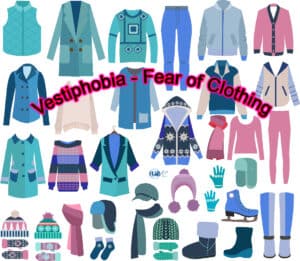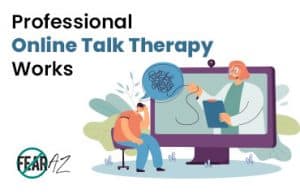Share This Article
Do Not Fear Clothing, Learn to Control this Phobia
Are loose clothes the only clothes you feel like you can breathe in? Does the thought of coming in contact with fabrics make you dread wearing any clothing? Do people give you strange looks when you explain this fear, or do they confuse it with exhibitionism?
If this sounds familiar, you may have vestiphobia, or a fear of clothing.
Living a normal life with a fear of clothing can be debilitating, especially when the only solution seems like self-isolation.
But not all hope is lost.
Overcoming your fear, no matter how severe, is possible with the right treatment plan. Acknowledging the fear and understanding what’s causing it is fundamental to overcoming or better managing your phobia.

What Is Vestiphobia?
The phobia of clothes, or vestiphobia, is a type of phobia classified under anxiety disorders in the DSM-V. Among all the phobias, vestiphobia is a rare one.
Someone suffering from vestiphobia develops an irrational fear of clothing. They avoid coming in contact with clothing and are often picky about their clothes or wear loose, oversized clothing.
However, not all cases of vestiphobia may manifest the same way.
Depending on the triggering event or stimuli, a person may fear only certain types of clothing or particular fabrics. In severe cases, the person may refuse to wear any clothing at all, resulting in them never leaving the house.
So, a fear of clothing, if left unchecked, may result in one isolating themselves.
In other cases, a person suffering from vestiphobia might also develop claustrophobia from wearing tight clothes.
Because of their fear of clothing, society often dismisses vestiphobes as nudists or exhibitionists, but those are two completely different things.
A vestiphobe is afraid of the itching or allergic reaction that clothing may cause, but exhibitionists and nudists simply do not wish to wear clothing.
What Causes Vesitophobia?
Vestiphobia causes, like most phobias and anxiety disorders, can include a variety of factors, both biological and environmental.
Biological factors or genetics suggest a link between a family history of mental illness and a high risk of developing anxiety disorders. So, having a family member with a mental illness or anxiety disorder puts you at a higher risk of developing vestiphobia.
On the other hand, environmental factors suggest a similar link between past experiences and phobia. Additionally, a person who watches a parent or relative struggle with vestiphobia might also develop it in the future.
The risk of developing phobias is also high for those who’ve had a traumatic experience in the past that involved fabric or clothing, such as a severe allergic reaction to a fabric.
Vestiphobia is also commonly seen in soldiers or people with a history of working in the military. With such individuals, the root cause may be a bad experience one has come to associate with certain items of clothing.
Another instance of a traumatic experience that leads to such fear is when a person grows up in an environment with strict and restrictive clothing rules.
Symptoms of Vestiphobia
The symptoms of vestiphobia and their severity can differ from person to person. But most people will experience at least three to five symptoms, which will last for at least six months or longer.
Physical Symptoms
- Increased heart rate
- Dry mouth
- High blood pressure
- Muscle tension
- Trembling
- Excessive sweating
- Irregular breathing
- Avoiding clothing
Psychological Symptoms
- Anxiety when thinking about clothes
- Anger, irritability, and mood swings
- Guilt, shame, self-blame
- Inability to cope with anxiety
- Panic attacks
- Feeling out of control
- An intense sense of doom
- Feeling trapped and unable to escape
Vestiphobia Treatments
Learning how to deal with vestiphobia is crucial if you don’t want the condition to worsen.
Phobias and anxiety disorders are treatable, but there’s no one solution that works for everyone. And that’s why professionals will often prescribe a treatment plan that includes one or more therapies.
However, to make therapy more effective, self-help solutions are also necessary.
Self-Help Strategies to Help Yourself
Self-help strategies may help reduce anxiety and panic responses while supporting the professional treatment plan.
Some accessible self-help practices you can incorporate into your routine are:
- Muscle relaxation
- Yoga
- Massage
- Exercising regularly
- Deep breathing
- Journaling
- Getting enough sleep
- Eating regular, healthy meals
- Reducing caffeine and alcohol
These self-help strategies may help reduce the severity of your symptoms, allowing you to work through the treatment.
Activities such as getting enough sleep, exercising regularly, eating a healthy diet, and practicing yoga can all help to improve your lifestyle. They help balance nutrition while also ensuring healthy movement and rest.
Reducing stimulants may also help, as stimulants may increase feelings of anxiety.
Professional Help for the Fear of Clothing
Seeking professional help for vestiphobia treatment is the most effective strategy for dealing with the fear. This involves receiving support and guidance from a therapist who suggests and supervises treatments that help you manage the fear.
Here are two of the most popular therapies in these treatments:
Cognitive Behavioral Therapy (CBT)
CBT is a very common therapy used in the treatment of anxiety disorders. CBT works to desensitize individuals towards their triggers or the object of fear by changing the way they think and react to it.
It helps one address all the excessive worry and irrational thinking around the fear to develop a better mental attitude.
Exposure Therapy
Exposure therapy works on treating phobias by gradually increasing a person’s exposure to the object of fear in a controlled environment.
Other popular therapies that your therapist may include are:
- Dialectical behavior therapy (DBT)
- Mindfulness-based stress reduction (MBSR)
- Hypnotherapy
While most professionals avoid prescribing medications, it may be necessary in severe cases with debilitating symptoms.
Learning to Cope with Vestiphobia
Coping with a phobia of clothing may seem difficult considering how essential clothing is to our social life.
Finding a support system in family and friends is one of the best ways to cope as you move through your treatment. Support and self-help both encourage the person to look forward to healing and boost the effectiveness of the therapy.
The more you learn to cope, the less resistance you’ll face carrying out everyday tasks like dressing up for the day or touching fabrics around the house.
The Takeaway
Since you’ve decided to tackle your fear of clothing, you’ve overcome the biggest hurdle! Now all that’s left to do is push through therapy while relying on loved ones’ support. And in no time, you’ll be able to relax and enjoy most any piece of clothing while socializing with freedom.




